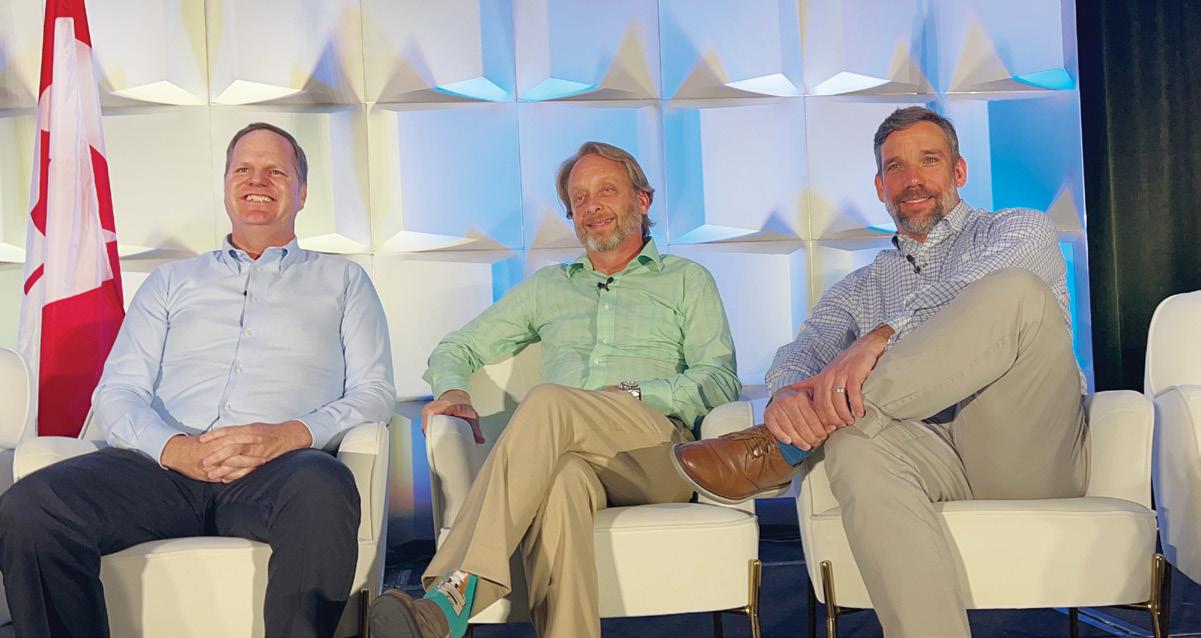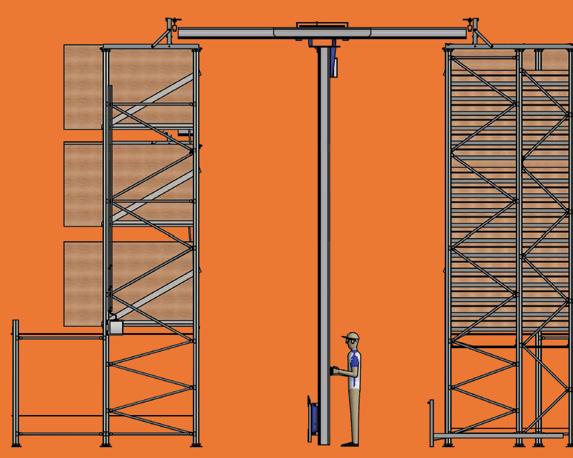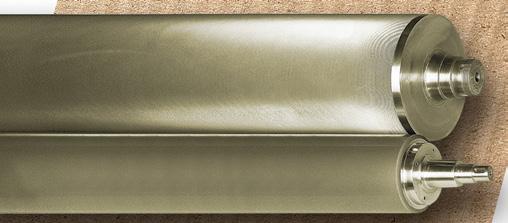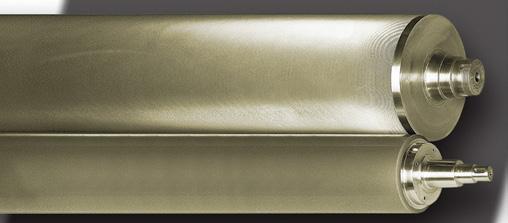
19 minute read
2022 MIDYEAR CONVERTERS ROUNDTABLE
one industry, like automotive. Th ere are times when some industries are down, but others are doing better, so we drop here and pick up there. Th at’s the safety you get in this area.”
Defi ning Forest Packaging’s customer base, Dean DeGroot, sales manager, says, “It’s a lot of brown boxes, RSCs, die cuts. And that’s been spread among many industries—food, automotive, plastics, metal stampers, and printers. We’re not concentrated in any one industry.” DeGroot says the company’s current mix is a 60-40 split of industrial packaging and graphics and display work.
Advertisement
Th e immediate payout from its recent, strategic investments is a greater opportunity for the company in new or underserved markets. Referring to the BW Papersystems three-color RDC, DeGroot says, “It’s made a huge diff erence in speed and graphics. I’m amazed at what we can do graphically now. We’ve picked up so much business just because of that. We used to have to turn away business—‘we can’t hold that print; we can’t do that.’ Now we can do just about anything.”
Jeff Kula also weighs in on the new market opportunities the company now enjoys, especially in light of the waning of the COVID-19 pandemic. “We really have had a lot of good opportunities presented to us,” he says. “We feel we’re in a good position as far as what we can do. And seeing how much more a blend of business that switched to e-commerce and direct-to-consumer, and now we’re seeing the retail side pickup, too.”
All the Kulas and DeGroot agree that their design department deserves the credit for stepping up to the challenge. “A lot of it comes from the design department, and how we’ve upgraded that,” DeGroot says. “Th e [Kongsberg] table, everything is now speed and how fast you can get that, and without the proper designers, the proper equipment, we were at a disadvantage.”
Forest’s designers, Bob Pucillo and Roger Lawlor, complement each other in their abilities, says John. “Roger’s more on the industrial side, and he’s very creative coming up with unique ways to protect the customer’s product,” he says. “Bob’s more on the displays, the higher-end stuff . Th e nice thing in watching the two of them work together—Roger’s picking up more on the higher end, and Bob’s also picking up on the industrial, brown side and coming up with solutions. It’s a fun process.”
Going Forward
Th e Forest Packaging leadership team will not rest on their oars as far as future planning is concerned. A new building is in their sights to allow for expansion and to increase their effi ciencies even more. Any visitor to the company will be impressed with how much throughput they’re getting in a small, 50,000-square-foot space. John Kula has plans for adding a surge line after the Geo. M. Martin bundle breaker is installed on the die cutter to allow more output. “It’s tight, and we’re trying to maneuver,” he says.
“We’re doing all this in pretty tight quarters. A new building is on the list. We could probably double our current footage tomorrow—that’s what we would need, at least 100,000 square feet.”
Challenge and Opportunity
Th e Forest Packaging leadership group sees challenges ahead but also opportunities. One of the most immediate problems facing the industry is the shortage of workers. “Labor shortages are a real problem,” says John.
To counter this trend, Forest Packaging is creating incentives for current employees. “We’re off ering bonuses to employees if they fi nd someone who will be a successful employee for us,” says Greg.
“We would rather incentivize the people here than pay a signing bonus to someone we do not know,” John adds.
On the fl ip side, Forest Packaging has automated its processes so that fewer new people will be needed in the years ahead. “You’re going to see a lot of companies go that route,” says John, “because the technologies and the things we’ve done have allowed us to operate with less.”
Th e greatest reason for optimism and opportunity in the future, says Greg, is the very nature of the corrugated industry itself: It’s essential, it’s sustainable, and it’s domestic. “We’re a vital industry,” he says. “If the corrugated box didn’t exist, how would everything get to market?”
“We as an industry have always been sustainable. Cutting trees, replanting trees, and recycling everything,” John adds. “We were doing that even before it was a cool thing to do.”
“Another good thing about our industry,” says Greg, “is we’re so domestic; most of our product is made here.”
“Whatever we can do, we make under our own roof,” adds John.
Positioned for Success
Every company has an elevator speech. When asked about Forest Packaging’s, John says, “We want to be your partner. If we can’t earn the business, then we don’t deserve the business.”
In an all-American, independent kind of way, Forest Packaging proves this daily. In response to its customers and the corrugated packaging market’s changing needs, Forest has pursued steady, purposeful investment in new capacity and improved throughput while staying true to its roots. A second generation of leadership—forward-looking and always customer-focused—is well-positioned for the next chapter of growth, ensuring what Greg Kula had in mind when he bought the company in 1991: A quality product, fast service, and longstanding relationships will build a successful business.
Steve Young is AICC’s ambassador-at-large. He can be reached at 202-297-0583 or syoung@aiccbox.org.
Boxmaker panel focuses on top-of-mind issues surrounding strategic growth and the importance of relationships
At the AICC Spring Meeting in Palm Desert, California, members were treated to several compelling addresses, plant tours, networking opportunities, and informative sessions and panel discussions. One of those panels, moderated by Joe Morelli, vice president of sales and marketing at Huston Patterson and Lewisburg Printing Co., off ered various key insights from a handful of leaders on the Association’s board. Th at session has been transcribed for BoxScore and is as follows.
MODERATOR
Joe Morelli
Vice President of Sales and Marketing HUSTON PATTERSON AND L EWISBURG PRINTING CO.
Gary Brewer
President
PACKAGE CRAFTERS
Finn MacDonald
President
INDEPENDENT II
Matt Davis
President PACKAGING EXPRESS INC.
Photo courtesy of AICC.
Panelists (from left) from AICC's Spring Meeting discussion on issues facing suppliers: Matt Davis, president, Packaging Express; Gary Brewer, CEO and president, Package Crafters; and Finn MacDonald, president, Independent II.

Joe Morelli: [AICC President] Mike D’Angelo and I did a session with [OTB Sales Solutions CEO and Founder] Mark Allen Roberts; if you haven’t heard him speak, he’s incredible. He’s got an incredible amount of data behind him. A lot of stuff he talked about was how the [COVID19] pandemic was going to change sales forever. So, the fi rst question, gentlemen, is: As you’ve come out of the pandemic, has it altered the way you’ve dealt with your suppliers? Gary Brewer: I’m back to normal, no restrictions. I encourage the face-toface—it’s what we all like, right? Whether somebody wants to shake hands with me or not is up to them. But back to what we used to do. I like the face-to-face. Finn MacDonald: Yeah, and I’d add to that it’s not only what we’re doing outside as far as letting folks in—it’s what we’re doing inside as far as getting groups together for training, trying to have working lunches, trying to put emphasis on getting ahead of problems rather than reacting to them. Th e past couple years have been a high percentage of reaction. Th e fact that internally we’re trying to open up and do more as a group, I think, only opens a door to our supply base.
Morelli: One of the statistics that Roberts threw out there was 70% of business-to-business buyers are comfortable purchasing up to about $50,000 worth of something without ever meeting their supplier. Is that something you think applies to you, or is that perhaps in a diff erent industry? Matt Davis: Yeah, I think it applies. It depends on the product and if it’s something you’re familiar with, maybe a bander or something like that. I think you can make those purchases without ever meeting the person.
Morelli: I think more staggering—he threw out a half-million dollars, 30% to 35% of buyers and purchasing agents would be comfortable purchasing up to $500,000 worth of product without ever meeting one of us. Brewer: I would say so. As long as you had a good, solid out if it didn’t meet your expectations. I did something recently— wasn’t that level, but it was more than $70,000—never met the folks. All email. MacDonald: I’d say 50-50. Certainly if we know you, or we know of you, you’ve got a better shot at that. Carte blanche is still something that we’re not natural with.
Morelli: On the same line of the buyers and the purchasing agents that you guys have been working with, you look around the corrugated industry, and it’s aging. It’s a very experienced industry; I think that’s widely said. What we’ve noticed is a lot of the purchasing agents are the younger generation, they’re more millennial. Th ey’re defi nitely younger than the bulk of us. Are there any tips on how we need to adapt to perhaps that younger buyer? MacDonald: I’d say from our perspective, the mix of your experienced gatekeepers versus your newer entrylevel buyers, or whoever a buyer is, the problem is you still have a gatekeeper. Th e gatekeeper is going to start the conversation by telling you how long they’ve been in the business, and then it’s going to go on and on and on. It’s nothing but a series of formed opinions. Usually, they’re blocking a lot of good eff ort and a lot of good intelligence and a

—Finn MacDonald, president, Independent II
lot of good education from even getting into the company.
Somehow, you’ve got to fi nd a way to get around the gatekeeper and get to all the hungry fi sh. Because we’re doing our job—we’re diversifying our company, we’re building for the future—but we’ve got plenty of departments throughout the country that need help from everybody in the room. I can’t sit there and open the door and get you through that gatekeeper to get there. I’m willing to help, but we’ve got to fi nd a way to get around it, because it’s what’s going to get everybody to stay in the industry. And it begins to form the relationships that bring us all together.
Morelli: Gary alluded to the relationships, the handshakes. Post-pandemic, I think a lot of people started to fi gure out you could be a lot more effi cient with your time if you’re not dealing with suppliers day in, day out. How much of that do you think is still true, or do you think old-school relationship-type sales is going to be around forever? Davis: I think it’s going to be around for a long time. Kind of dovetailing on your question earlier, being a smaller business, about $70,000 would be our threshold, but any bigger purchases, we do want to have that relationship. Th e nice thing about the box business is throughout this whole pandemic, we never missed a shift. We’re used to going in to the offi ce; it’s still kind of business as usual, and it’s defi nitely getting back to business as usual. I would say that we want that. At least, that’s how we’re still making decisions. We want to see the suppliers.
Morelli: Moving out of the post-pandemic discussion, one of the questions that we get quite often is: What makes a great supplier? You were talking about getting around the gatekeeper and fi guring out a way to make yourself known to your team of people. In your opinion, other than a great product, how can you be a good supplier if you’re Independent II? MacDonald: I guess I had to learn my way up, so a lot of the memories that have built the relationships that allow us to do large amounts of business without seeing anybody, they were built press-side. Th ey were built at dinners. Th ey might have been built out in the lobby. By just the
exchange of information, not even related to what you’re selling and what I’m looking for, but general stated business, “How are things going? What are you hearing?” I think if you can hit press-side, if you can hit dinner, if you can hit context, then you’re bringing value.
I’ve got a plant. Half of my production staff is not the same production staff that anybody in this room knew three years ago. I’ve got a new head of maintenance that was not here three years ago. I’ve got a new design department that wasn’t here three years ago. We’re open for new opportunities, for relationships, but we’re in a desperate need for knowledge, and we need that information to be brought to us in a way that’s accessible by a lot of folks who’ve never been in the business. Don’t tell me how much you know; help somebody who knows nothing learn something. Make that fi rst step. If you can bring that to us, then you’re going to be able to crawl, and then walk, and run pretty successfully. Brewer: I’ll add to that. I say, “Educate me.” Us three guys, we sell for a living, right? We’ve got our customers, we’re in all shapes and sizes, diff erent industries. We see all diff erent methods, practices. We try to help those customers, “Hey, I’ve seen somebody do this a certain way,” build their trust. I say the same thing of you guys. You go in all diff erent types of plants, locations—you see everything—so come into my plant and educate me on something that you’ve seen. It may not even be related to the product you’re selling or off ering, right? Show me something. Th ere is no chip on my shoulder—I want to work smarter, not harder. Help me and educate me, and that, in turn, will grow.
Morelli: I think what you’re alluding to, and one of the questions, actually, I had from somebody in the audience today was, during your onboarding process for new employees, is it something that you lean on your suppliers for, to help them get caught up to speed quickly? Or is that something you just take internally? Brewer: I would encourage that. Th at just makes you deeper with me, right? If you’re an ink supplier, come pressside and help that operator or assistant operator understand what the ink is, and how to adjust it, and how to make it perform properly. Bring your knowledge and experience and help me; take that burden off . Davis: I would agree with that. Help us establish some best practices. Th e sale doesn’t stop after you get the PO—we need that help all the way through. And then after, come back six months later and do an audit or help us put processes in place that catch any ineffi ciencies or bad habits. Th at’s what we would defi nitely appreciate.
Morelli: One of the big questions, I know, especially when I was a young sales rep in the industry, was, “How do we get to you?” Finn, you mentioned maybe it’s just at a coff ee break. But is AICC a good platform for one of these people to come and put the hard sell on you on their product, or is it more to make the introduction and get to know you fi rst? What would you say to this group in terms of how to get to the 400 general members that are here? MacDonald: It’s tough. [Laughter.] I mean that in a loving way to everybody in the room. It’s kind of tough to get to me, and that’s a lot on me. We’ve got a lot going on, but everybody has a lot going on, right? Th ere’s not a person in the room who’s twiddling their thumbs. If there is, shame on you. It’s tough, but getting to me is really, really diff erent than getting to my plant manager, my design manager, my buyer, my sheet buyer, and my maintenance manager. We’ve got to fi nd a way to get to those folks. It’s the groups working under them, in our company—they’re not folks who’ve been there for 25 years. Th ey’re folks who’ve been there for three months, a year, for three to fi ve years. So there’s plenty of opportunity for them to learn.
As far as getting to me, the one thing I was going to ask the room would be this: You guys have such a great network. Chances are, if fi ve of you want to get to me, one of you is getting to me, so I would try to use the network to say, “Who in the hell’s getting ahold of Finn right now? Can you let him know that we’re trying to get ahold of him?” Let’s just help each other out. I think you do a natural job with that. But I’d say I could use the help there, because a lot of times you just get inundated, but there is somebody who’s “I’m picking up the phone to talk to Greg. Greg and I are doing something.” So, you’ve got the access. Use your coconut line, your coconut-palm
—Gary Brewer, president, Package Crafters
“I do feel that habits have changed. Whether it’s out of fear or convenience, people are ordering stuff online. And it’s kind of ‘What do you want to do with your Saturday?’ and it’s not ‘Go shop at Target.’
—Matt Davis, president, Packaging Express Inc.
tree line, and help each other out that way. We’re OK if you’re a little devious in how you get to us. You’re a resourceful group. Davis: I would say for all the newer members, I would encourage you to come to the meetings. I know some Associates skipped some of our meetings because they might feel a little boring or not as informative to you, but the sessions we had this afternoon applied to both boxmakers and Associates. And the nice thing about those meetings is the boxmakers are at the tables. You can even pick who you want to sit with. If you’re new to the group, I think that’s a great way to try and get to know some other folks. And then I would just encourage you to keep coming, because with that repetition, you really get to know people. It’s hard that fi rst or second time, but my advice would be to keep coming, and we’ll do what we can. MacDonald: Joe, I think I’d add to that. I tell you, I still dedicate a good amount of time to old media, to our publications, and I’m extremely bullish and optimistic about our new media. Th ere’s a new channel that the Association’s working on, and I think the combination of that and our existing print media—we’re down a publication, but we’re also backfi lling that—that is something that I guarantee you our leadership group, we get two copies of each. We take it home, we do go through that page by page. Normally, it’s when we’re not at the offi ce and there’s not a lot else going on, so it’s really, really good learning time in our example.
With the new channel that’s coming, I tell you, the amount of times we go through the break room, look out on the parking lot, we see our production staff looking at their phones. Th ey’re looking for something. Th ey want to see how something runs or how you set something up better. It’s such a golden opportunity to get right to the ground level, and I think we’re right at the dawn of that. I think it’s going to actually be easier that way as you work through new and old media to augment what you’re trying to achieve. Brewer: Something I’ll add—and I think bankers are extremely eff ective at this— call us after 5. Because we’re there [all nodding in agreement] and nobody else. And guess what—answering the phone.



The Measure of Quality.
PRECISION GLUE SETS









Accora glue sets elevate the industry standard for low-TIR precision and durability. Dual-clad stainless steel glue rolls & ceramic doctor rolls never flake, banish corrosion, and deliver a consistently accurate gap. Save time, starch, & energy with Accora.



Get on board with Apex Glue it. Print it. Profit.
apexinternational.com/industry/corrugated
Morelli: Better be careful what you wish for, Gary. [Laughter.] It makes sense, though.
You talked a little bit about machinery in this last topic. Th ere’s a lot of machine reps in the audience today, a couple up on stage, too, so please chime in, if you have anything to add to the discussion. Considering today’s business conditions, the climate we’re in, the machine lead times, how are you guys projecting? How are you looking so far down the road to say, “Oh, I need a new









